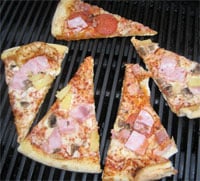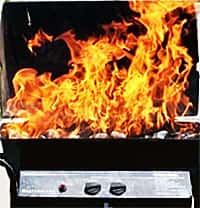Balcony BBQ – Using a Gas BBQ on a Unit Balcony
There are many great small sized BBQs that are well suited to having a BBQ on a balcony.
But before you invest in a new BBQ, or use an existing BBQ on your unit balcony, there are a few things to consider:
Decision Criteria for a Balcony BBQ
- Compliance with by-Laws of the complex or body corporate
- Lease restrictions, if you are a renter
- Adequate ventilation
- Limits on the amount of gas
- Safe distance from combustible materials
- Safe distance from ignition sources
- Accessible fire extinguisher
- Minimising cooking smoke
- Controlled cleanup
By-Laws:
You need to check the By-Laws for your complex and/or check with your Body Corporate to see if there are any restrictions on using a gas BBQ on your balcony.
Many do have restrictions and some provide gas BBQs in common areas, as an alternative.
Lease Restrictions
If you are a renter, you also need to check your lease to see if it includes any restrictions regarding the use of a BBQ on the balcony.
Open and Ventilated
The balcony must be open and well ventilated. It cannot be enclosed by louvres, plastic curtains or similar weather or privacy barriers.
If your balcony is enclosed, you cannot use a BBQ under any circumstances.
 Only One Bottle
Only One Bottle
You are limited to no more than one 9kg gas bottle on the balcony.
So, you cannot store a spare gas bottle on the balcony along with the gas bottle attached to the BBQ.
Also, NEVER store gas bottles indoors.
Combustible Materials
You should make sure that there are no flammable materials near the BBQ.
 This would include timber walls, railings, furniture, privacy screens or anything else that can burn.
This would include timber walls, railings, furniture, privacy screens or anything else that can burn.
It should also be placed well away from windows or doors, as carpeting, curtains and wood blinds are also flammable.
Gas bottles and BBQs should be kept a minimum of 1M away from any wall opening.
Ignition Sources
 Your BBQ and gas bottle should be at least 1.5M away from any electrical ignition source like electrical switches, power points, air conditioners, lights, bug zappers, etc.
Your BBQ and gas bottle should be at least 1.5M away from any electrical ignition source like electrical switches, power points, air conditioners, lights, bug zappers, etc.
The same distance should be maintained from any open flame, like decorative or citronella candles.
This applies at all times, whether the BBQ is in use or not.
Check for Gas Leaks
Fire Extinguisher
 While not common, BBQ fires do happen.
While not common, BBQ fires do happen.
In contrast to a backyard BBQ, it is unlikely that a garden hose is available on your balcony for fire emergencies.
So, your only option is to have a fire extinguisher at the ready.
Something a bit larger than the small ones sold for kitchens would be prudent.
Cooking Smoke
 Be aware that your cooking smoke may not just go straight up and away.
Be aware that your cooking smoke may not just go straight up and away.
While you may enjoy the smell of the meal you are about to eat, it is unlikely that your neighbours will feel the same way about your smoke coming into their units.
You can minimise your smoke in a few ways:
1. Don’t cook on HIGH, as cooking with higher heat generates more smoke.
2. Make sure your grease tray is clean before you start, to avoid the smoke generated from heating old grease.
3. Finally, make sure you keep an eye on your BBQ so nothing burns while cooking.
Be a good neighbour!
Clean-up
 Remember that you cannot use water to clean your BBQ if it is going to spill over the edge of your balcony.
Remember that you cannot use water to clean your BBQ if it is going to spill over the edge of your balcony.
Having greasy, dirty water dripping onto their balconies and blowing into their windows will do nothing for your popularity with your neighbours.
It may even get you presented with expensive cleaning bills!
Basic Gas BBQ Safety
We saved the most important bit for last. You need to follow all of the standard gas BBQ Safety Guidelines.
In particular, make sure your do your soapy water leak checks when installing a fresh bottle and turn the gas bottle OFF when the BBQ is not in use.
Also, always store your gas bottle upright and outdoors.
16 BBQ Cooking Tips for Great Grilling
1. Ice it, Cook it or Eat it
Keep it clean and keep it cold until you cook it or eat it.
Practice good food safety and preparation.
2. Oil Me Up!
 You should always season the grill.
You should always season the grill.
Pre-heat the clean grill and coat with cooking oil, using a brush or spray.
Close the grill and allow it to sit for about 20 minutes then wipe the grill clean with a fresh damp cloth.
The concept is the same as the seasoning of a cast iron fry pan.
3. To Be or Not to Be Open… That is the Question
So, how do you position the BBQ lid?
Just as some things are cooked on the kitchen cooktop and some in the oven, the type of food you are cooking will determine if you leave the BBQ lid up or down.
Generally speaking, do what you would do if you were cooking indoors.
4. Now We’re Cooking – Outside In
Steaks, burgers, and veggies, that need to be seared or cooked from the outside inward, should be placed directly over the burners.
A little olive oil brushed on the steak will prevent it from sticking.
Do NOT use salt on the meat before cooking, as it draws out the moisture and makes the meat dry.
If you do salt it as you start cooking, use coarse salt to get a nice salty crust.
A bit of coarse black pepper can be nice, too.
5. Stunning Striped Steaks
 Always pre-heat the grill and take the meat out of the refrigerator about 15 minutes before cooking.
Always pre-heat the grill and take the meat out of the refrigerator about 15 minutes before cooking.
Sear the meat for 90 seconds on high heat and then rotate it 1/8 of a turn (45 degrees) and sear again.
This will give it an attractive crosshatch pattern, assuming you are not cooking on a flat plate grill, and help seal in the natural juices.
Remember to reduce heat to normal cooking temperature after searing.
6. I Need My Space
You should only turn the meat once. Be patient!
The meat needs room, too. Don’t overcrowd the grill or it can heat unevenly.
There should be at least 2cm between the pieces of meat.
Also, make sure you have enough gas so that the cooking session is uninterrupted.
 7. No Poking, Prodding or Mashing
7. No Poking, Prodding or Mashing
To retain the natural juices, don’t poke holes in the meat! This includes piercing the sausage skins.
Use long handled tongs or spatulas instead of BBQ forks.
Also, don’t mash down on meat and burgers, as it forces out the natural juices and leaves you with dried out meat.
8. Leave Me Alone… I’m Resting
Let your grilled meat “rest” for five minutes after cooking, covered loosely with foil, to ensure more tender and juicy results.
Letting the meat rest also applies to roasts and other cooked meats, as well.
9. Slow Cooking – Inside Out
 Whole chickens, roasts, and most fish fillets require indirect heat.
Whole chickens, roasts, and most fish fillets require indirect heat.
Try preheating the grill with all burners then, when the grill is hot, turn off one side of grill, put the slow cooking food over the unlit burners and close the lid.
In effect, it becomes an oven. This will help cook the meat evenly, browning it while keeping it juicy and tender.
Use a meat thermometer, where appropriate, to determine when it is done.
10. Pouch Protector Preparation
 You can use aluminium foil to create little cooking pouches for delicate foods, like fish fillets.
You can use aluminium foil to create little cooking pouches for delicate foods, like fish fillets.
Cook away from the lit burners or place the pouch on the warming rack, if you have one.
11. Warm & Wonderful
You can toast bread, cook delicate foods or just keep cooked food warm by using your warming rack.
12. I’m Smokin’!!!
 Wood chip smoke can enhance the flavour of your food.
Wood chip smoke can enhance the flavour of your food.
You put the wood chips in a steel smoker box or in a small aluminium foil tray within the BBQ.
Hickory is a good all-round choice, if you are just starting.
Smoker boxes and wood chips can be found at BBQ specialty stores. Follow the wood chip supplier’s instructions.
13. Leftover Pizza?
 Did you know that a gas grill is the perfect way to reheat pizza?
Did you know that a gas grill is the perfect way to reheat pizza?
Just set the BBQ on low, preheat, put the pizza directly on the grill and close the lid.
Heat until cheese starts to melt.
14. Flare Up? Lid Down!
 Use lean cuts of meat and/or trim away the fat to reduce the chance of flare ups.
Use lean cuts of meat and/or trim away the fat to reduce the chance of flare ups.
Make sure the grease tray is empty before you start, too. Very high temperatures should also be avoided.
However, if it does happen, flip down the grill lid and turn OFF all burners and the gas bottle, if safe to do so.
When the flare up is over, you can resume cooking.
NEVER spray water on BBQ flare ups or on any grease fire.
15. Marvelous Marinated Meat
 For more intense or varied flavours, consider using meat marinades.
For more intense or varied flavours, consider using meat marinades.
You marinate the meat before you BBQ, as instructed by the marinade maker or recipe.
You can use large freezer bags for marinating.
Just put in the meat and marinade, seal and shake. Refrigerate, shaking it occasionally, until you’re ready to BBQ.
Make sure you drain off any excess marinade before cooking and do NOT pour it over the meat while cooking.
 16. A Little Something on the Side
16. A Little Something on the Side
If your BBQ is equipped with a side burner, you can use it just like a kitchen cooktop.
This adds to the selection of dishes you can choose to cook outdoors.
New Residential LPG customer?
New Business LPG customer?
Existing ELGAS customer?
- Elgas to the Rescue with Helicopter LPG Delivery - November 14, 2024
- Outdoor Gas Heater – Outdoor Mushroom Heater – Gas Patio Heater Guide: - September 22, 2024
- LPG Meaning – LPG Means: What Does LPG Stand For - August 31, 2024
Steve Reynolds
Technical Consultant
Steve Reynolds is a leading expert in the LPG industry with over 22 years of experience. As part of the national management team at ELGAS, Steve ensures the safe and efficient storage, handling, and transportation of LPG. He serves as the lead investigator for incidents and collaborates with authorities on industry developments.
Steve is a technical advisor to Standards Australia and Gas Energy Australia (GEA), and an active member of the World LPG Association (WLPGA), contributing to global standards and technical reviews. He holds a BSc. (Hons) in Industrial Chemistry from UNSW and has held senior safety and technical roles at ELGAS, making him a trusted authority in LPG safety and standards.
